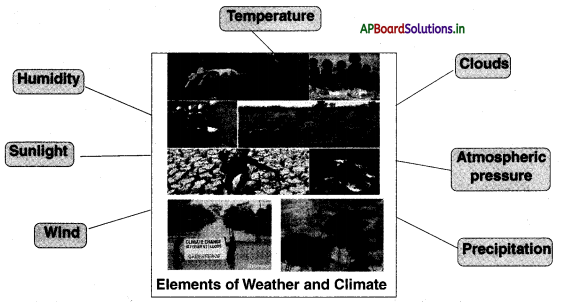Students can go through AP State Board 10th Class Social Studies Notes Chapter 4 Climate of India to understand and remember the concept easily.
AP State Board Syllabus 10th Class Social Studies Notes Chapter 4 Climate of India
→ What have been the general conditions, year after year over thirty years or more gives us the climate,
→ The elements of weather and climate are temperature, atmospheric pressure, wind, humidity, and precipitation,
→ Climograph shows average monthly values of maximum temperature, minimum temperature, and rainfall for a given place.
→ The factors that affect climate are called climatic controls. These include
- Latitude
- Land-water relationship
- Relief and
- Upper air circulation.
→ The average temperatures for the year drop as you go further away from the Equator.
→ Darker areas such as heavily vegetated regions tend to be good absorbers; lighter areas, such as snow and ice-covered regions, tend to be good reflectors.
→ The difference between the temperature of day and night and that of summer and winter is not much. This is known as ‘equable climate’.
→ Hills and mountains will have lower temperatures than locations on the plain.
→ The climate of India is affected by the movement of upper air currents in the atmosphere above 12,000 m called ‘Jet Streams’.
→ The temperature in the Indian landmass considerably reduces from Mid-November and this cold season continues till February.
→ During the hot season, as we move from the southern to the northern part of the country, the average temperature increases.
![]()
→ The monsoon forms in the tropical area approximately between 20eN and 208S latitudes,
→ The bulk of annual rainfall in India is received from the southwest monsoon.
→ The retreat of the monsoon is marked by clear skies and a rise in temperature.
→ As the Earth started to take shape from a fire bail to a planet, many gases were released.
→ These gases did not escape into outer space because of the Earth’s gravitational pull, and it still holds them back.
→ The atmosphere traps a lot of solar energy that reaches the Earth by preventing it from totally escaping back into space. This is called the Greenhouse effect.
→ Much of the warming has been occurring since thelhdfiStrfal Revolution is because of human activities. Hence, the current global warming is Anthropogenic Globed Warming.
→ Methane is said to be even more powerful than carbon dioxide as a greenhouse gas. c& AGW (Anthropogenic Global Warming) is causing many changes in the distribution of heat in the Earth system.
→ One of the human activities that contribute to global warming is deforestation.
→ An international effort to form an agreement whereby all countries try to reduce their emission of greenhouse gases has so far not been achieved.
→ Climograph: Graphs that show average monthly values of maximum temperature, minimum temperature, and rainfall for a given place.
→ Weather: The state of the atmospheric conditions over an area at a particular time.
→ Monsoon: The seasonal reversal of wind system in India.
→ Insolation (IncomIng solar radiation): The heat coming from the Sun to the Earth’s surface In the form of rays.
→ Jet streams: The fast flowing upper air currents in a narrow belt In the upper atmosphere above 12,000 m.
→ Pressure zone: The exertion of force by one body on the surface of another.
→ Global Warming: Atmosphere traps a lot of solar energy that reaches Earth by preventing it from totally escaping into space This is called Global Warming.
![]()
→ Climate Weather conditions followed a similar general pattern over many years over a large area.
→ Climatic controls The factors that affect climates like latitude, relief, land-water relationship, and upper air circulation.
→ Equable climate: The climatic condition where the differences between the temperatures of day and night and summer and winter are not much
→ Trade winds: Winds blowing from sub4roplcal high-pressure belt to equatorial low-pressure belt by reflecting towards the west are called trade winds.
→ Western disturbances: Cyclone depressions coming from the mediterranean sea.
→ Loo: A dry hot wind that blows In the northern plain of India.
→ Bursting monsoon: The pre-monsoon showers towards the end of the summer season in the Deccan Plateau.
→ Mango showers: The pre-monsoon showers In Andhra Pradesh helping the early ripening of mangoes.
→ The onset of the monsoon: By the beginning of June, the arrival of the Arabian Sea branch and the Bay of Bengal branch in India is called the onset of the monsoon.
→ The onset of the monsoon: By the beginning of June, the arrival of the Arabian Sea branch and the Bay of Bengal branch in India is called the onset of the monsoon.
→ Anthropogenic Global Warming: Global warming that is caused by humans since the Industrial Revolution.
→ October heat: WIth high temperature and humidity, the weather becomes oppressive during the retreat of the monsoon is called October heat.

